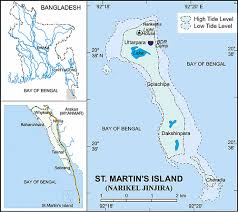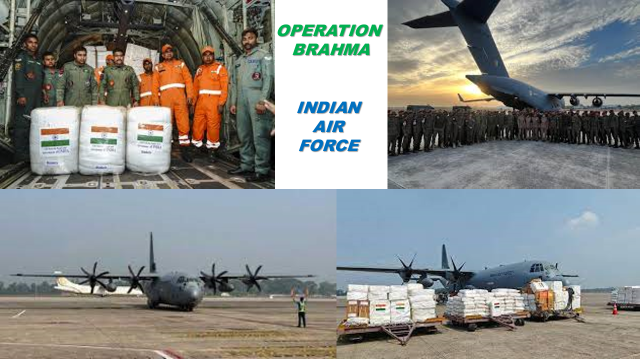My article was published in Issue 4 (May 25) of the SP Aviation journal.
On March 28, 2025, a devastating 7.7-magnitude earthquake struck Myanmar, claiming over 3,649 lives and injuring more than 5,000 people. In response, India launched Operation Brahma, a humanitarian assistance and disaster relief (HADR) mission, to deliver critical supplies, medical teams, and rescue personnel to the affected regions. The IAF deployed six military transport aircraft, including C-130J Super Hercules and C-17 Globemaster, to ferry 625 metric tons of aid to cities such as Yangon, Nay Pyi Taw, and Mandalay.
The Incident
The first reported incident of GPS spoofing occurred on March 29, when a C-130J aircraft, carrying 15 tons of relief material from Hindon Airbase to Yangon, experienced navigation anomalies in Myanmar’s airspace. Subsequent flights reported similar issues, with sources indicating that most of the six aircraft involved in the operation encountered GPS spoofing on multiple sorties. After the initial incident, IAF pilots were briefed to anticipate such challenges, enabling them to prepare for and mitigate the risks on subsequent flights.
The IAF later clarified that a Notice to Airmen (NOTAM) issued by Mandalay International Airport highlighted the possibility of degraded GPS availability. The NOTAM warned of potential navigation issues in Myanmar’s airspace, and IAF crews were trained to operate under such conditions. Despite the disruptions, all missions were completed successfully, with no reported accidents or deviations from the planned routes. This underscores the professionalism and preparedness of the IAF pilots, providing reassurance about their capabilities in challenging situations.
GPS Spoofing
GPS spoofing is a form of electronic warfare where false signals are broadcast to deceive a receiver, causing it to calculate an incorrect position. Unlike GPS jamming, which blocks signals entirely, spoofing manipulates data to mislead navigation systems, potentially directing an aircraft off course. The technique exploits the weak signal strength of GPS satellites, which can be overpowered by stronger, fraudulent signals generated from ground-based or airborne platforms. GPS spoofing is increasingly common in conflict zones, where state and non-state actors deploy electronic warfare to disrupt adversaries.
Modern military aircraft, however, are equipped with additional navigation systems, such as INS, which uses gyroscopes and accelerometers to track position independently of external signals. The IAF’s prompt switch to INS ensured safe navigation, but the incident highlighted the vulnerability of GPS-dependent systems in contested environments.
Attributability
Myanmar’s complex political landscape provides critical context for the incident. Since the military coup in 2021, the country has been embroiled in civil conflict, with the junta facing resistance from ethnic insurgent groups and pro-democracy forces. The region is also a geopolitical flashpoint, with major powers like China, India, and the United States vying for influence. China, in particular, has made significant strategic inroads in Myanmar, including infrastructure and military cooperation investments.
Some reports speculated that the spoofing may have been linked to Chinese-enabled systems, given Beijing’s advanced electronic warfare capabilities and presence in the region. The proximity of the interference to the Coco Islands, where China is suspected of developing surveillance and electronic warfare facilities, fueled these suspicions. However, attributing responsibility is difficult due to a lack of definitive evidence.
Other potential actors include non-state militant groups or regional adversaries seeking to cause disruption as a geopolitical signal. Myanmar’s airspace, described as a conflict zone, is particularly susceptible to such interference, with GPS spoofing reported as a common tactic in similar environments globally. Investigating spoofing in foreign airspace is nearly impossible due to limited access and jurisdictional constraints. Myanmar’s junta’s lack of transparency, restricted internet access, and communication controls further complicate any efforts to investigate the incident.
IAF Response and Mitigation
The IAF’s response to the GPS spoofing incidents was swift and effective. The pilots’ training in handling navigation anomalies allowed them to transition seamlessly to INS, ensuring the safe completion of all missions. The pre-emptive NOTAM from Mandalay International Airport also played a crucial role, enabling crews to anticipate and prepare for degraded GPS availability. This response highlights the IAF’s operational resilience in such challenges.
On April 14, the IAF clarified that its crews were well-equipped to operate in environments with compromised GPS signals. The statement avoided directly referencing spoofing, focusing instead on the successful execution of Operation Brahma and the robustness of IAF protocols. This measured response likely aimed to avoid escalating tensions in an already volatile region while highlighting India’s operational resilience.
The incident has sparked discussions within India’s defence establishment about enhancing countermeasures and navigation redundancies. Recommendations include installing real-time interference detection systems, conducting regular audits of navigation vulnerabilities, and advocating for international standards to counter GPS spoofing. The urgent need for global cooperation against electronic warfare is also underscored.
Broader Global Implications
The Myanmar incident is part of a global surge in GPS interference, with similar cases reported near the India-Pakistan border, the Middle East, and Eastern Europe. Spoofing has affected civilian and military aircraft globally, with notable cases like the 2024 Azerbaijan Airlines crash linked to GPS disruption and widespread interference in the Baltic and Black Sea regions.
For military operations, GPS spoofing poses risks beyond navigation errors, including compromised mission security and potential airspace violations. The Myanmar incident underscores the need for robust countermeasures, such as encrypted navigation systems and alternative positioning technologies like Galileo or India’s NavIC. This highlights the importance of preparedness in electronic warfare and the need for robust countermeasures.
Civilian aviation also faces growing risks, as commercial aircraft rely heavily on GPS for navigation, raising concerns about passenger safety. To enhance resilience, the aviation industry is exploring solutions like multi-constellation receivers, which integrate signals from multiple satellite systems, and ground-based navigation aids.
Geopolitically, the incident highlights the challenges of operating in contested regions. It underscores the need for diplomatic efforts to establish international norms against electronic warfare, though enforcement remains difficult in conflict zones.
Lessons Learned and Mitigation Measures
The Myanmar GPS spoofing incident offers several lessons for India and the global aviation community. First, it emphasises the importance of pilot training and redundant navigation systems, which proved critical in averting disaster. Second, it highlights the need for real-time intelligence sharing among allies to map and counter interference trends. Groups like OPSGROUP, which tracks aviation risks, could play a pivotal role in this effort.
Technologically, the incident underscores the urgency of developing spoofing-resistant navigation systems. Advances in quantum positioning, which relies on atomic clocks, and machine learning-based anomaly detection could reduce dependence on vulnerable GPS signals. India’s investment in NavIC, a regional navigation system, offers a potential alternative, though its coverage remains limited compared to GPS.
There is also a case for a global ban on GPS spoofing, similar to existing prohibitions on laser attacks against aircraft. While such measures face resistance from states with advanced electronic warfare programs, they could set a precedent for protecting peaceful humanitarian missions. Regional cooperation, particularly within ASEAN, could also address the region’s airspace vulnerabilities, though political instability poses challenges.
Conclusion
The GPS spoofing of IAF aircraft during Operation Brahma was a stark reminder of modern aviation’s evolving threats. While the IAF’s preparedness ensured the mission’s success, the incident exposed the fragility of GPS-dependent systems in conflict zones. As electronic warfare becomes more sophisticated, nations must invest in resilient technologies, robust training, and international collaboration to safeguard military and civilian operations. The incident reinforces India’s role as a responsible regional power capable of overcoming adversity to deliver aid. Still, it also signals the need for vigilance in an increasingly contested digital landscape.
Please Add Value to the write-up with your views on the subject.
For regular updates, please register your email here:-
References and credits
To all the online sites and channels.
Pics Courtesy: Internet
Disclaimer:
Information and data included in the blog are for educational & non-commercial purposes only and have been carefully adapted, excerpted, or edited from reliable and accurate sources. All copyrighted material belongs to respective owners and is provided only for wider dissemination.
References:-
- India Today. “Cyber-attack on IAF aircraft involved in Myanmar quake relief op, say defence sources.” April 13, 2025.
- The Hindu. “Frequent GPS interference, including ‘spoofing’, near India’s border with Pakistan, Myanmar.” December 28, 2024.
- The Print. “Operation Brahma: IAF aircraft flying into earthquake-hit Myanmar faced GPS spoofing.” April 14, 2025.
- First post. “Indian Air Force aircraft faced massive cyber attacks in Myanmar airspace during aid mission: Report.” April 13, 2025.
- India Sentinels. “What is ‘GPS spoofing’ that the Indian Air Force’s transport aircraft faced in Myanmar airspace?” April 14, 2025.
- The Times of India. “IAF jet cyber-attack: IAF jet on Myanmar relief operation faced cyber-attack in the air.” April 14, 2025.
- ANI News. “IAF issues clarification on GPS spoofing incident during Myanmar relief operations.” April 14, 2025.
- Rediff.com. “IAF jets faced ‘GPS spoofing’ during Myanmar relief mission.” April 13, 2025.
- The Economic Times. “IAF planes faced GPS spoofing in Myanmar’s airspace while carrying relief materials for quake victims: Sources.” April 13, 2025.
- Mathrubhumi English. “IAF aircraft face GPS spoofing over Myanmar during quake relief mission.” April 13, 2025.
- Eurasian Times. “U.S.-Supplied C-130J, C-17 Come ‘Under Attack’ Over Myanmar; What Happened With IAF Aircraft?” April 14, 2025.



